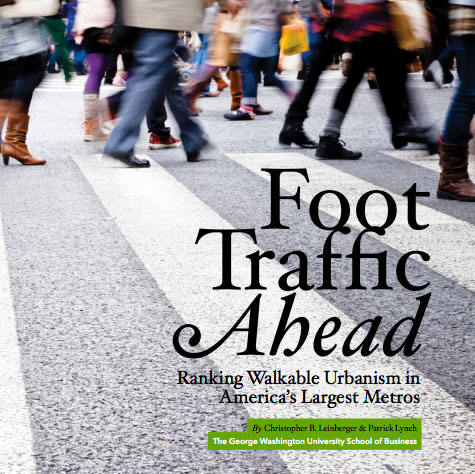
Authors
Publication Date
June 2015
Categories
Tags
Resource Type
Learn more about LOCUS
LOCUS is Smart Growth America's coalition of responsible real estate developers and investors. Learn more about their work ››
Foot Traffic Ahead: 2014
This report indicates that metros found to have high walkable urbanism are models for the future development patterns of many—and possibly most— of the largest 30 U.S. metros.
These trends suggest future demand for tens of millions square feet of walkable urban development and hundreds of new WalkUPs.
This demand would provide an economic foundation for the U.S. economy, similar to the building of drivable suburbs in the mid to late 20th century
Key findings
- There are 558 WalkUPs, or regionally significant, walkable urban places, in the 30 largest metropolitan areas in the United States.
- The 30 metros are ranked according to their current walkable urbanism and categorized into four levels:LEVEL 1: High Walkable Urbanism Metros that augur the end of sprawl, as their current development is concentrated in creating and expanding WalkUPs rather than drivable sub-urban areas.
LEVEL 2: Moderate Walkable Urbanism Metros that are developing both drivable sub-urban and walkable urban places, but are trending more toward a walkable urban future.
LEVEL 3: Tentative Walkable Urbanism Metros that are trending toward WalkUP development in their central cities—along with a few examples in suburbs—despite being dominated by drivable sub-urban patterns.
LEVEL 4: Low Walkable Urbanism Metros that continue to build in the drivable sub-urban pattern. Any brights spots of walkable urbanism tend to be located in revitalizing center cities. - Future-oriented metrics show that some metropolitan areas, such as Miami, Atlanta, Los Angeles and Denver, are making some surprising and unexpected shifts toward walkable urban development.
- The most walkable urban metro areas have substantially higher GDPs per capita and percentages of college graduates over 25 years of age in the population. These relationships are correlations. Determining the causal relationships will require further research.
- Walkable urban office space in the 30 largest metros commands a 74 percent rent-per-square-foot premium over rents in drivable suburban areas. And, these price premiums continue to grow.
- Walkable urban development is not limited to the revitalization of center cities; it is also the urbanization of suburbs.
Foot Traffic Ahead 2016
This research was released again in June 2016. Read the 2016 edition ››